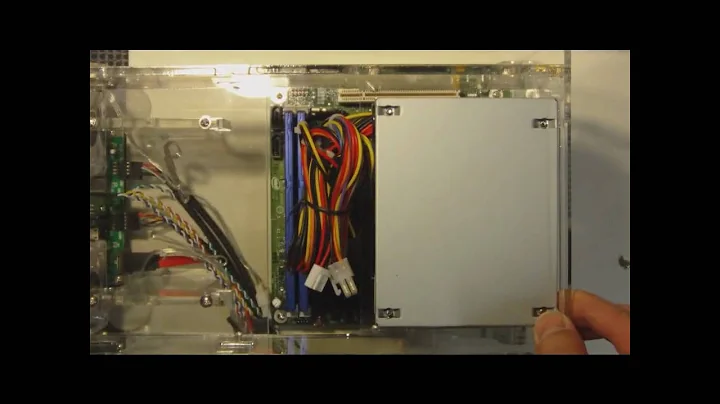Boost your productivity with a mid-range Ryzen workstation!
Table of Contents
- Introduction
- CPU Choice - AMD Ryzen 5 1600
- Motherboard Selection - AB350 Gaming 3
- Memory - Corsair Vengeance LPX 16GB Kit
- Graphics Card - NVIDIA Quadro 4000
- Power Supply - EVGA 500W
- Storage - Sandisk 240GB SSD and Seagate Barracuda 500GB HDD
- Chassis - Fractal Design Focus G
- Building the Workstation PC
- Final Thoughts
Introduction
Hey there, guys! Welcome back to the Channel! In today's video, we have something special in store for you. We're not building a gaming rig this time. Instead, we're diving into the world of workstations. Specifically, we'll be building a mid-range workstation PC for my beloved father-in-law and cousin, who happen to work together at their family-owned machine shop. They do a lot of 3D modeling, rendering, and working with AutoCAD. Their current system is outdated and struggling to keep up. So, it's high time for an upgrade to improve their workflow and productivity.
CPU Choice - AMD Ryzen 5 1600
Let's start by discussing our CPU choice. After careful consideration, I've decided to go with the AMD Ryzen 5 1600. While Intel offers some viable options for mainstream workstations, AMD's Ryzen CPUs provide an excellent balance between performance and affordability. The Ryzen 5 1600 boasts six cores and twelve Threads, making it a powerhouse for multi-threaded workloads. This particular CPU is priced around $200-210, which is a fantastic price-to-performance ratio. To save some money, we'll be using the included Wraith Spire cooler, which is surprisingly effective for a stock cooler.
Pros:
- Excellent price-to-performance ratio
- Six cores and twelve threads for multi-threaded workloads
Cons:
- Stock cooler might not be sufficient for heavy overclocking
Motherboard Selection - AB350 Gaming 3
Now, let's talk about the motherboard. We've chosen the Gigabyte AB350 Gaming 3. While it's technically a gaming-oriented motherboard, it perfectly suits our needs. Priced around $110, it offers all the necessary features and connectivity options for this build. It's important to note that I already had this motherboard on HAND, so it made sense to use it. However, you could easily find a cheaper motherboard that would still get the job done.
Pros:
- Sufficient connectivity options
- Affordable price
Cons:
- Gaming-oriented aesthetics may not be to everyone's taste
Memory - Corsair Vengeance LPX 16GB Kit
Moving on to memory, we've opted for the Corsair Vengeance LPX 16GB kit. This kit consists of two 8GB sticks running at 3200MHz. Apologies for the confusion in the video where I mistakenly Mentioned a 2133MHz kit. These higher-frequency modules will be more suitable for our Ryzen system, providing faster and smoother performance. With 16GB of RAM, our workstation will have plenty of memory for multitasking and handling demanding tasks.
Pros:
- High-frequency modules for better performance
- Ample 16GB capacity for multitasking
Cons:
Graphics Card - NVIDIA Quadro 4000
Now, let's discuss the graphics card. For a workstation PC, I've chosen the NVIDIA Quadro 4000. While gaming cards can sometimes suffice for 3D modeling software, I wanted to ensure maximum compatibility and optimized performance with the applications my father-in-law and cousin use. The Quadro 4000 provides precise calculations and is specifically designed for workstation applications. It may not offer the same gaming performance as consumer-grade GPUs, but for our purposes, it's an ideal choice. This refurbished card costs around $200, making it a cost-effective solution.
Pros:
- Optimized for workstation applications
- Affordable refurbished option
Cons:
Power Supply - EVGA 500W
Next up, let's talk about the power supply. We've selected the EVGA 500W unit. While it may not have all the fancy bells and whistles of higher-end power supplies, it gets the job done reliably. Being 80 Plus certified, it ensures efficient power delivery while keeping costs low. Although it's not modular and doesn't feature sleek black cables, it provides a safe and sufficient amount of power for our system.
Pros:
- Affordable and reliable
- 80 Plus certified for efficiency
Cons:
- Non-modular design may lead to more cable clutter
Storage - Sandisk 240GB SSD and Seagate Barracuda 500GB HDD
Let's move on to storage. For the boot drive, we've chosen the Sandisk 240GB SSD. While it may be a budget option, it offers a significant improvement in speed compared to traditional mechanical drives. This SSD will ensure fast boot times and Snappy system responsiveness. Additionally, we've included a Seagate Barracuda 500GB HDD for additional storage needs. These drives may not be the most cutting-edge options, but they offer reliable and affordable storage solutions.
Pros:
- SSD provides fast boot times and system responsiveness
- HDD offers ample storage capacity at a budget-friendly price
Cons:
Chassis - Fractal Design Focus G
Moving on to the chassis, we have the Fractal Design Focus G, and I must say, I'm quite excited about this one. Priced at around $50, it offers a sleek and budget-friendly design. The large side panel window adds a touch of style, which is not commonly found in cases at this price point. The case also features excellent airflow with a meshed front panel, allowing for optimal cooling. It comes with two white LED 120mm fans, providing both functionality and aesthetics. While there are a few minor critiques, such as the small cutout for the HD audio connector and the flimsy power supply Dust filter, overall, the Focus G is a solid case with ample space and great cable management options for its price.
Pros:
- Sleek design with large side panel window
- Excellent airflow and included fans
- Budget-friendly price
Cons:
- Small cutout for HD audio connector
- Flimsy power supply dust filter
Building the Workstation PC
Now that we have all the components, it's time to dive into the exciting process of building the workstation PC. My wife, who graciously assisted me in this video, proved to be an invaluable help. We followed a straightforward and smooth process, with everything fitting nicely inside the Fractal Design Focus G case. The cable management options were well thought out, allowing us to route the cables neatly and keep everything tidy. The system looks handsome, even though the colors may not be perfectly matched. Overall, building inside this $50 case was a pleasant experience, offering enough space and convenient cutouts for cable routing.
Final Thoughts
In conclusion, we have successfully built a mid-range workstation PC that will significantly enhance my father-in-law and cousin's workflow and productivity. The combination of the AMD Ryzen 5 1600 CPU, Gigabyte AB350 Gaming 3 motherboard, Corsair Vengeance LPX 16GB RAM, NVIDIA Quadro 4000 graphics card, EVGA 500W power supply, Sandisk 240GB SSD, Seagate Barracuda 500GB HDD, and Fractal Design Focus G chassis provides a powerful and reliable system for their needs. While there may be a few minor critiques, this budget-friendly workstation PC offers exceptional value for its performance.
Thank you so much for watching, and I'd love to hear your thoughts on this build. If you have any experience building a workstation for editing or 3D modeling, feel free to share your insights in the comments below. Don't forget to give this video a thumbs up if you enjoyed it, and consider checking out the Tech Ultra membership for ad-free early access to my content. Until next time, Take Care, and I'll see you in the next video!
Highlights
- Build a mid-range workstation PC for 3D modeling and rendering.
- AMD Ryzen 5 1600 offers excellent price-to-performance ratio.
- Gigabyte AB350 Gaming 3 provides ample connectivity options.
- Corsair Vengeance LPX 16GB RAM ensures smooth multitasking.
- NVIDIA Quadro 4000 offers optimized performance for workstation applications.
- EVGA 500W power supply delivers reliable and efficient power.
- Sandisk 240GB SSD and Seagate Barracuda 500GB HDD provide ample storage capacity.
- Fractal Design Focus G offers a sleek design and excellent airflow at an affordable price.
- Building process goes smoothly, thanks to the well-designed case and cable management options.
- The completed workstation PC will significantly improve workflow and productivity.
FAQ
Q: Can I use a gaming GPU instead of the NVIDIA Quadro 4000 for 3D modeling?
A: While gaming GPUs can sometimes work adequately for 3D modeling, it's recommended to use a workstation GPU like the Quadro 4000. Workstation GPUs are specifically optimized for professional applications, ensuring better stability and support.
Q: Can I upgrade the storage capacity in the future?
A: Absolutely! The Fractal Design Focus G case provides ample space for additional storage drives. You can easily add more SSDs or HDDs to suit your future storage needs.
Q: Is the included power supply sufficient for this build?
A: Yes, the EVGA 500W power supply is more than enough to handle the components in this workstation PC. It's reliable and efficient, ensuring stable power delivery.
Q: Can I overclock the AMD Ryzen 5 1600?
A: While the Ryzen 5 1600 can be overclocked, the included Wraith Spire cooler may not be sufficient for heavy overclocking. If you plan to overclock, consider investing in a more powerful aftermarket cooler for better thermal performance.
Q: Can I use this workstation PC for gaming as well?
A: While this PC is primarily designed for workstation tasks, it can also handle gaming to some extent. However, if gaming is your primary focus, you might want to consider different components, such as a more powerful gaming GPU and faster RAM.


 6.3K
6.3K
 29.81%
29.81%
 3
3


 24.9K
24.9K
 16.55%
16.55%
 66
66


 < 5K
< 5K
 25.2%
25.2%
 10
10


 161.6K
161.6K
 54.33%
54.33%
 12
12


 45.7K
45.7K
 16.2%
16.2%
 45
45


 43.1K
43.1K
 17.49%
17.49%
 24
24


 < 5K
< 5K
 31.09%
31.09%
 3
3


 134.6K
134.6K
 63.43%
63.43%
 10
10


 10.6K
10.6K
 13.52%
13.52%
 14
14
 WHY YOU SHOULD CHOOSE TOOLIFY
WHY YOU SHOULD CHOOSE TOOLIFY


































